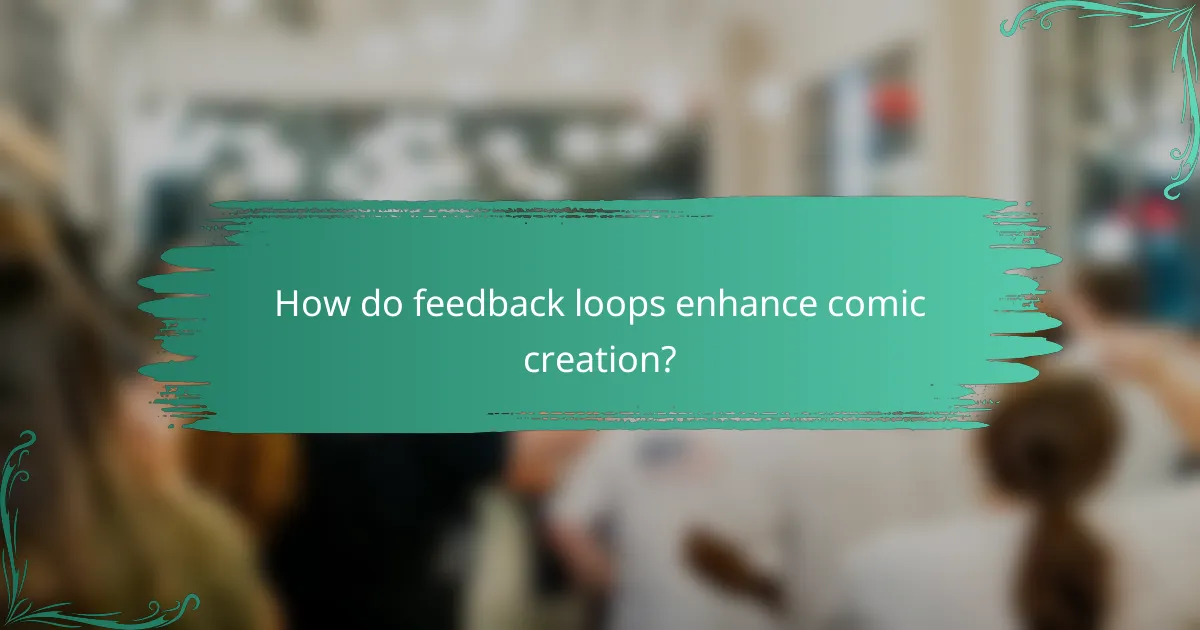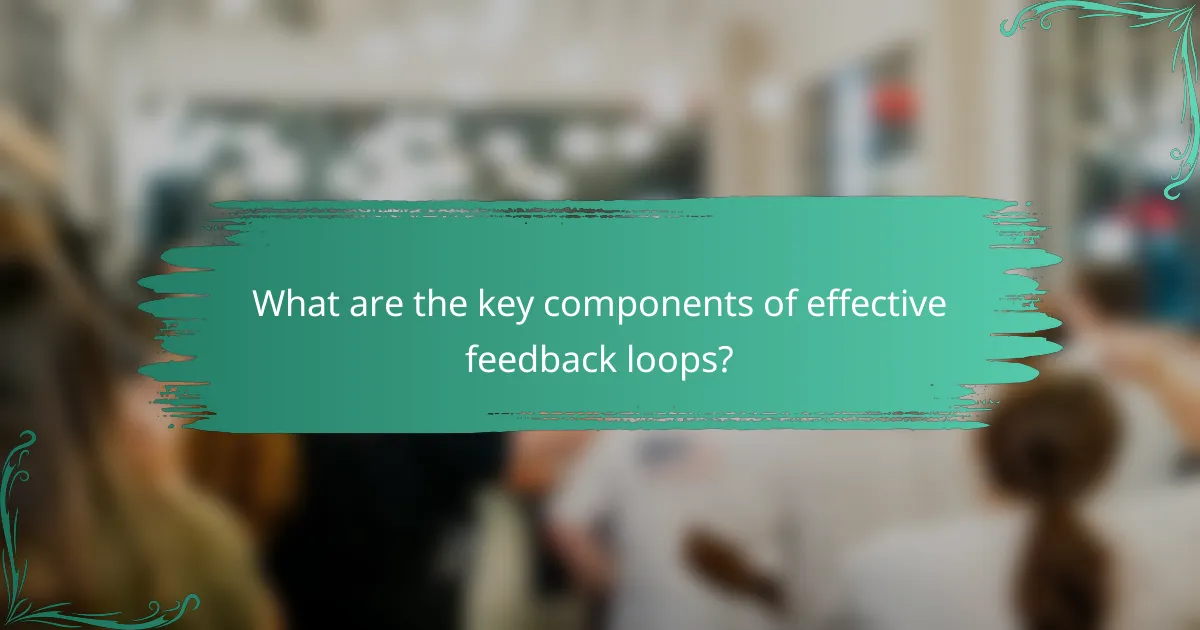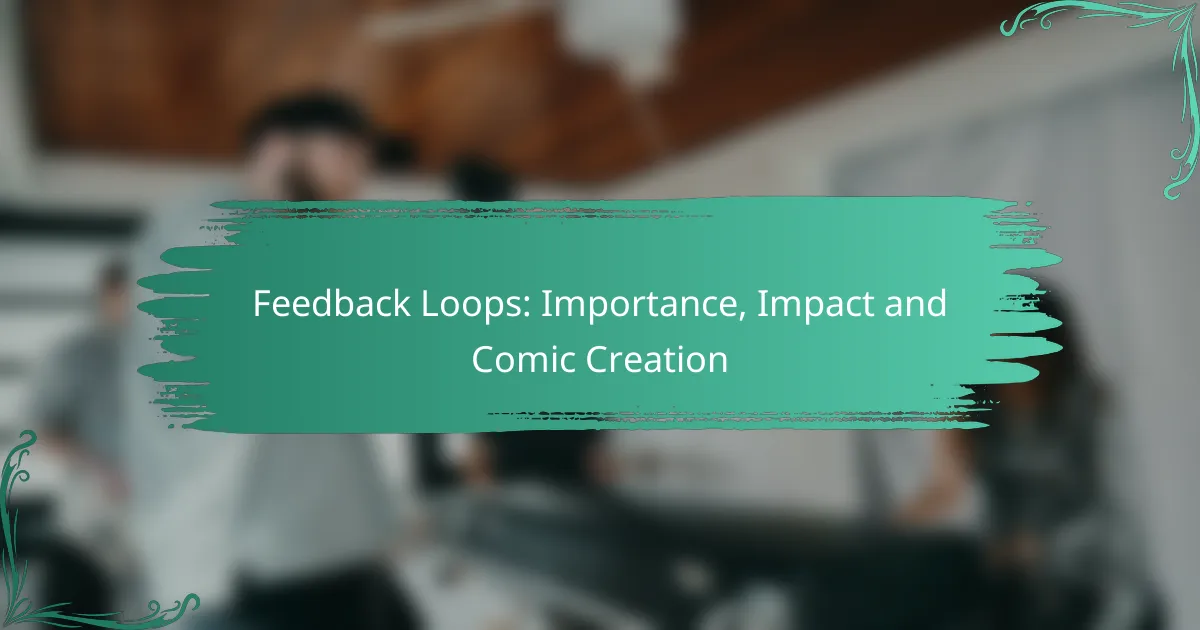Feedback loops play a crucial role in the comic creation process by enabling creators to gather valuable insights from their audience. This iterative approach not only enhances storytelling and character development but also fosters stronger audience engagement, resulting in a more refined and appealing final product.

How do feedback loops enhance comic creation?
Feedback loops significantly enhance comic creation by allowing creators to gather insights from readers and iterate on their work. This process fosters continuous improvement in storytelling, character development, and audience engagement, ultimately leading to a more polished final product.
Improved storytelling
Feedback loops enable comic creators to refine their narratives based on reader reactions. By analyzing comments and critiques, writers can identify which plot points resonate and which fall flat. This iterative process helps in crafting more compelling and cohesive stories that keep readers invested.
For instance, if early feedback indicates confusion about a character’s motivation, the creator can adjust the storyline to clarify intentions, enhancing overall narrative flow. Regularly seeking reader input can lead to stronger, more engaging plots.
Character development
Character development benefits greatly from feedback loops as creators can gauge audience attachment to characters. Insights from readers can reveal which characters are favorites and which may need more depth or backstory. This allows for targeted enhancements that deepen emotional connections.
For example, if a character receives mixed feedback regarding their actions, the creator can explore additional layers to their personality or motivations, making them more relatable and multi-dimensional. Engaging with readers can lead to richer character arcs.
Audience engagement
Feedback loops play a crucial role in boosting audience engagement by fostering a sense of community between creators and readers. When creators actively solicit and respond to feedback, it encourages readers to feel valued and invested in the comic’s development.
Creators can implement strategies such as surveys or social media polls to gather opinions on story directions or character designs. This not only enhances the comic but also builds a loyal fan base eager to participate in the creative process, leading to increased readership and support.

What are the key components of effective feedback loops?
Effective feedback loops consist of clear communication channels, regular reviews, and actionable insights. These components ensure that information flows smoothly, evaluations occur consistently, and the feedback provided leads to tangible improvements.
Clear communication channels
Clear communication channels are essential for effective feedback loops as they facilitate the exchange of information between all parties involved. This can include direct conversations, emails, or collaborative platforms that allow for real-time discussions.
Establishing these channels requires setting expectations for responsiveness and clarity. For instance, using specific tools like Slack or Microsoft Teams can help maintain ongoing dialogue and ensure that feedback is not lost or overlooked.
Regular reviews
Regular reviews are crucial for assessing progress and integrating feedback effectively. These reviews can be scheduled weekly, monthly, or quarterly, depending on the project’s scope and timeline.
During these reviews, it is important to evaluate both the feedback received and the actions taken in response. This practice helps identify patterns and areas for improvement, ensuring that the feedback loop remains dynamic and productive.
Actionable insights
Actionable insights are the key outcomes of effective feedback loops, transforming feedback into specific, implementable actions. These insights should be clear and concise, allowing teams to prioritize tasks based on their impact and feasibility.
To generate actionable insights, consider using frameworks like SMART (Specific, Measurable, Achievable, Relevant, Time-bound) to guide the development of feedback into concrete steps. This approach helps avoid ambiguity and ensures that feedback leads to meaningful changes.

How can comic creators implement feedback loops?
Comic creators can implement feedback loops by actively seeking input from their audience throughout the creative process. This approach allows for continuous improvement and alignment with reader preferences, ultimately enhancing the quality of the final product.
Utilizing beta readers
Beta readers are individuals who review a comic before its official release, providing valuable insights on story, pacing, and character development. Selecting a diverse group of beta readers can help identify different perspectives and preferences, ensuring a broader appeal.
When working with beta readers, provide them with specific questions to guide their feedback. This can include inquiries about plot clarity, character relatability, and overall enjoyment. Aim for a group size of 5 to 10 readers to gather a range of opinions while keeping the process manageable.
Incorporating surveys
Surveys are an effective way to collect structured feedback from a larger audience. They can be distributed online through platforms like Google Forms or SurveyMonkey, allowing creators to gather quantitative and qualitative data efficiently.
When designing a survey, focus on key areas such as story engagement, art style preferences, and character appeal. Use a mix of multiple-choice questions and open-ended responses to capture both specific ratings and detailed comments. Aim for a completion time of under 5 minutes to encourage participation.
Hosting focus groups
Focus groups involve gathering a small group of readers to discuss their thoughts on a comic in a guided setting. This method fosters in-depth conversations and can reveal insights that surveys might miss.
To host a successful focus group, select 6 to 10 participants who represent your target audience. Prepare a set of discussion prompts to steer the conversation, and consider recording the session (with permission) for later analysis. Keep the session to about 1 to 2 hours to maintain engagement and focus.

What are the benefits of feedback loops in comics?
Feedback loops in comics enhance the creative process by providing valuable insights that lead to improved storytelling and art. They allow creators to refine their work based on audience reactions, ultimately resulting in a more engaging final product.
Increased quality
Feedback loops contribute to increased quality in comics by enabling creators to identify strengths and weaknesses in their work. Regular input from readers can highlight areas that need improvement, such as character development, pacing, or visual clarity.
For example, a comic artist might receive feedback on a particular panel that confuses readers. By addressing this issue, the artist can enhance the overall storytelling and ensure that the narrative flows smoothly.
Faster iteration
Faster iteration is another significant benefit of feedback loops in comics. By continuously gathering and implementing feedback, creators can make quicker adjustments to their work, reducing the time spent on revisions. This agile approach allows for more frequent updates and releases.
For instance, a webcomic creator might publish new strips weekly, using reader comments to refine their style and content with each installment. This process can lead to a more dynamic and responsive storytelling experience.
Stronger community ties
Feedback loops foster stronger community ties among creators and their audiences. Engaging with readers through comments, social media, or surveys creates a sense of belonging and investment in the comic’s success.
When creators actively seek and respond to feedback, they build a loyal fan base that feels valued and heard. This connection can lead to increased support, whether through crowdfunding, merchandise purchases, or word-of-mouth promotion.

What challenges do comic creators face with feedback loops?
Comic creators often encounter several challenges when dealing with feedback loops, including managing criticism, aligning feedback with their creative vision, and navigating time constraints. These factors can significantly impact the quality and direction of their work.
Overwhelming criticism
Receiving feedback can sometimes lead to overwhelming criticism, which may discourage comic creators. Negative comments, especially when numerous, can overshadow constructive suggestions and create self-doubt.
To manage criticism effectively, creators should focus on identifying actionable insights rather than getting bogged down by harsh remarks. It can be helpful to categorize feedback into constructive and non-constructive to prioritize what to address.
Balancing feedback with vision
Comic creators must balance external feedback with their original vision, which can be challenging. While feedback can enhance a project, it may also lead to compromises that dilute the creator’s unique style or message.
To maintain this balance, creators should establish clear goals for their work and use feedback selectively. They can ask themselves whether the feedback aligns with their vision before making changes, ensuring that their artistic integrity remains intact.
Time constraints
Time constraints are a significant challenge for comic creators, as they often have tight deadlines to meet. This pressure can limit the time available for incorporating feedback, leading to rushed decisions that may not fully address concerns.
To mitigate time-related issues, creators should set realistic timelines for feedback incorporation and prioritize key areas for improvement. Developing a structured feedback schedule can help ensure that revisions are made without sacrificing quality or creativity.
